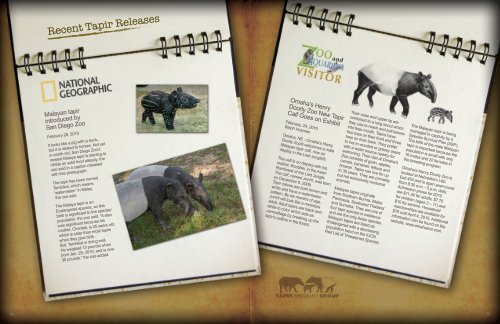About Tapirs - Tapir Specialist Group
About Tapirs - Tapir Specialist Group
About Tapirs - Tapir Specialist Group
Create successful ePaper yourself
Turn your PDF publications into a flip-book with our unique Google optimized e-Paper software.
Recent <strong>Tapir</strong> Releases<br />
Malayan tapir<br />
introduced by<br />
San Diego Zoo<br />
February 28, 2010<br />
It looks like a pig with a trunk,<br />
but it is related to horses. Not yet<br />
a month old, San Diego Zoo’s<br />
newest Malaya tapir is starting to<br />
nibble on solid food already, the<br />
zoo said in a caption released<br />
with this photograph.<br />
The tapir has been named<br />
Tembikai, which means<br />
“watermelon” in Malay,<br />
the zoo said.<br />
The Malaya tapir is an<br />
Endangered species, so this<br />
birth is significant to the species’<br />
population, the zoo said. “It also<br />
was significant because his<br />
mother, Chantek, is 25 years old,<br />
which is older than most tapirs<br />
when they give birth.<br />
But, Tembikai is doing well.<br />
He weighed 13 pounds when<br />
born Jan. 29, 2010, and is now<br />
30 pounds,” the zoo added.<br />
Omaha’s Henry<br />
Doorly Zoo New <strong>Tapir</strong><br />
Calf Goes on Exhibit<br />
February, 24, 2010<br />
Steph Husman<br />
Omaha, NE - Omaha’s Henry<br />
Doorly Zoo® welcomes a male<br />
Malayan tapir calf, now on<br />
display in the Lied Jungle®.<br />
The calf is on display with his<br />
mother, Knobbie, in the Asian<br />
Rainforest of the Lied Jungle.<br />
The calf, named JonHi, was born<br />
on December 6, 2009.<br />
<strong>Tapir</strong> calves are born brown and<br />
white and have a watermelon<br />
pattern. By six months of age,<br />
JonHi will look like a miniature<br />
adult. Adult tapirs are black and<br />
white in color which acts as<br />
camouflage by breaking up the<br />
tapir’s outline in the forest.<br />
Their nose and upper lip are<br />
combined to a long snout which<br />
they use to reach and pull leaves<br />
into their mouth. <strong><strong>Tapir</strong>s</strong> have<br />
four toes on their front and three<br />
toes on their back. They prefer<br />
to live in wooded or grassy areas<br />
with a water source nearby for<br />
swimming. Their diet at Omaha’s<br />
Zoo consists of grain, apples,<br />
carrots, bananas, lettuce and<br />
browse. <strong><strong>Tapir</strong>s</strong> can live for up<br />
to 30 years. They are primarily<br />
but not exclusively nocturnal<br />
animals.<br />
Malayan tapirs originate<br />
from Southern Burma, Malay<br />
Peninsula, Southeast Thailand<br />
and Sumatra. They are one of<br />
four tapir species in existence<br />
and are the only Asian species.<br />
Malayan tapirs are listed as<br />
Endangered with a decreasing<br />
population trend on the IUCN<br />
Red List of Threatened Species.<br />
The Malayan tapir is being<br />
managed in captivity by a<br />
Species Survival Plan (SSP).<br />
The birth of the male Malayan<br />
tapir is important because the<br />
population is small with only<br />
19 males and 22 females in<br />
the breeding program.<br />
Omaha’s Henry Doorly Zoo is<br />
located at Nebraska’s I-80,<br />
Exit 454 and is open year-round<br />
from 9:30 a.m. - 5 p.m. daily.<br />
Admission prices for 2010<br />
are $11.50 for adults, $7.75<br />
for children (ages 3 – 11) and<br />
$10 for seniors. Household<br />
memberships are available for<br />
$78 until April 4, 2010. Additional<br />
information can be found on the<br />
website, www.omahazoo.com.<br />
30 31










